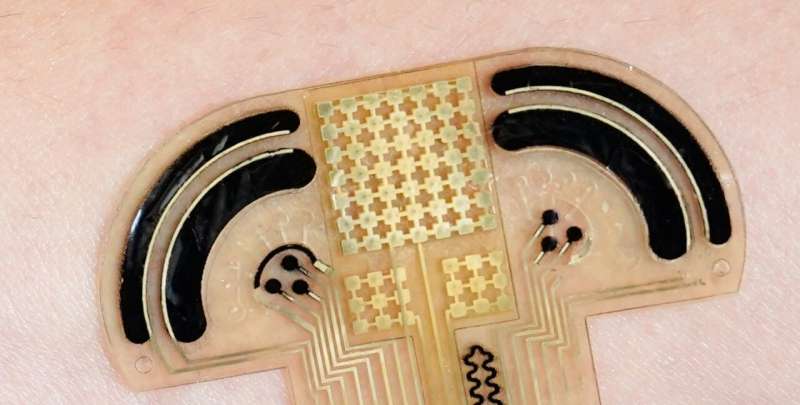‘Electronic skin’ continuously monitors nine markers that indicate a stress response
In the latest of a series of innovative designs for wearable sensors that use sweat to identify and measure physiological conditions, Caltech’s Wei Gao, assistant professor of medical engineering, has devised an “electronic skin” that continuously monitors nine different markers that characterize a stress response.
Those wearing this electronic skin—a small, thin adhesive worn on the wrist, called CARES (consolidated artificial-intelligence-reinforced electronic skin)—are free to engage in all their normal daily activities with minimal interference during testing, which allows for the measurement of both baseline and acute levels of stress.
The paper describing the CARES device, titled “A physicochemical sensing electronic skin for stress response monitoring,” was published in the January 19 issue of Nature Electronics.
Stress is a slippery concept. We talk about “feeling stressed” or a situation “being stressful,” and we may attach stress to physical symptoms: “I have a stress headache” or “I’m grinding my teeth at night. It must be stress.” The term stress can apply to all sorts of feelings, symptoms, behaviors, and experiences.
Hans Selye, a physician and chemist born in Vienna in 1907, was the first to define stress as a medical condition. Struck by the similar complaints—such as tiredness, low appetite, and lack of motivation—that he heard from patients suffering from very different illnesses, Selye speculated that all of the patients were responding to what they had in common: Being sick. He defined stress as a “nonspecific response of the body to any demand.”
Stress may be experienced positively as excitement or energy, or negatively as shock or anxiety. But however stress may be experienced emotionally, it is now widely agreed that depending on its severity and duration, both acute and chronic stress can damage our physical and mental health, and reduce our ability to function as we would like.
Because stress is, as Selye described it, “nonspecific,” there is no single biomarker available to tell us definitively whether or how much a person is stressed. However, stress generates a constellation of bodily reactions that, taken together, can provide a measure of stress independent of self-reports. Gao is monitoring this constellation with CARES.
“When a person is under stress, hormones like epinephrine, norepinephrine, and cortisol are released into the bloodstream,” explains Gao, who is also an investigator with the Heritage Medical Research Institute and a Ronald and JoAnne Willens Scholar.
“Sweat becomes rich with metabolites like glucose, lactate, and uric acid, and electrolytes like sodium, potassium, and ammonium. These are substances we have measured before using microfluidic sampling on a wearable sweat sensor.
“What is new in CARES is that sweat sensors are integrated with sensors that record pulse waveforms, skin temperature, and galvanic skin response: physiological signals that also indicate stress in predictable ways,” says Gao.
More information:
Changhao Xu et al, A physicochemical-sensing electronic skin for stress response monitoring, Nature Electronics (2024). DOI: 10.1038/s41928-023-01116-6
California Institute of Technology
Citation:
‘Electronic skin’ continuously monitors nine markers that indicate a stress response (2024, January 22)
retrieved 23 January 2024
from https://techxplore.com/news/2024-01-electronic-skin-markers-stress-response.html
This document is subject to copyright. Apart from any fair dealing for the purpose of private study or research, no
part may be reproduced without the written permission. The content is provided for information purposes only.

Comments are closed